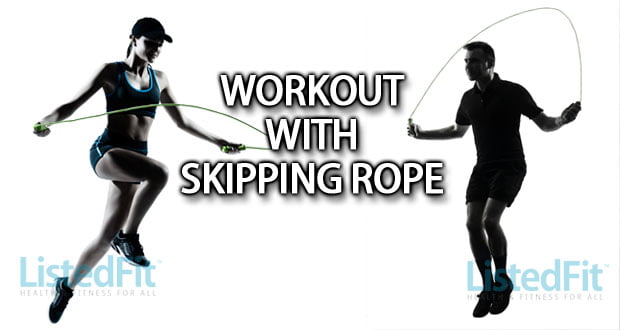Is Calisthenics Better Than Weights? Comparing Exercise Benefits and Effectiveness

ListedFit is reader-supported. When you buy through links on our site, we may earn a small commission.
When it comes to fitness and strength training, two popular methods often spark debate: calisthenics, which focuses on bodyweight exercises, and weight training, relying on external resistance for muscle-building.
Both forms of exercise can offer a variety of benefits, with some differences based on individual preferences, goals, and fitness levels.
In this article, we will be examining the key differences between these two approaches and highlighting factors to consider when choosing between them.
Quick Summary

Calisthenics has long been praised for its simplicity, accessibility, and versatility, requiring little to no equipment and allowing individuals to use their body weight for resistance. In contrast, weight training typically involves free weights or resistance machines to develop and strengthen muscles.
While calisthenics can develop balance, flexibility, and endurance, weight training often allows for more targeted muscle growth and stamina. It’s essential to weigh the pros and cons of each method, taking into account your personal goals, lifestyle, and preferences.
Key Takeaways
- Calisthenics and weight training differ in their use of body weight vs external resistance, providing diverse benefits and challenges.
- Essential home calisthenic equipment can include a pull-up bar and parallel bars, while weight training may require a more extensive range of weights and machines.
- Selecting the right approach comes down to individual needs, performance enhancement goals, and injury prevention considerations.
Table of Contents
Calisthenics vs Weight Training: Core Differences
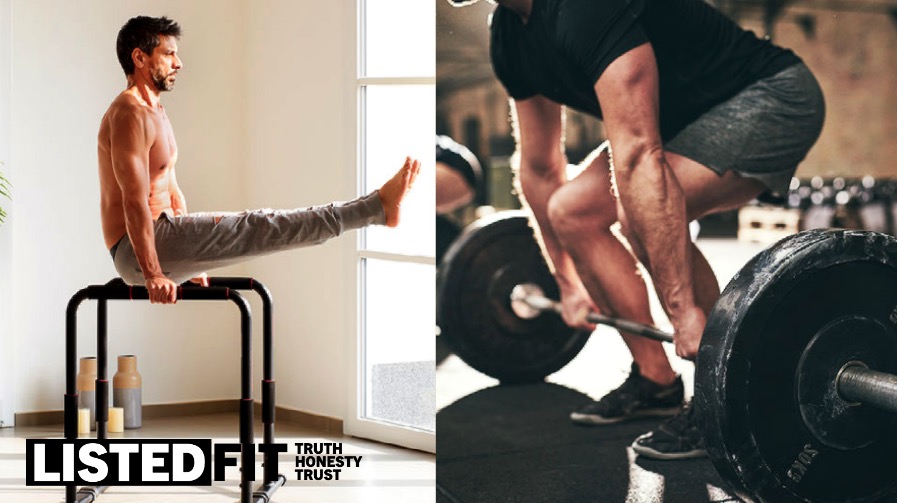
Calisthenics vs Weight Training Basics
When it comes to strength training, the key difference between calisthenics and weights is the type of resistance used.
In calisthenics, you use your own body weight as resistance, whereas weight training involves lifting external weights like dumbbells, barbells, or kettlebells.
Both methods will help you increase your muscle strength, but they differ in the exercises and techniques employed.
Calisthenics usually involves compound exercises that engage multiple muscle groups at once, helping to improve overall fitness, balance, and coordination.
Some popular calisthenic exercises include push-ups, pull-ups, squats, and lunges.
Weight training, on the other hand, often targets specific muscles or muscle groups in isolation, allowing for more focused muscle development.
For example, bicep curls, leg extensions, and bench presses are common weightlifting exercises.
Equipment and Cost
One major benefit of calisthenics over weight training is the minimal need for equipment.
Most of the exercises can be done using just your body weight, and perhaps a pull-up bar or push-up handles for some variations.
This means you can often perform calisthenics at home, in a park, or in any open space without needing a pricey gym membership or any expensive equipment.
Weight training, however, usually requires access to a variety of free weights or machines, which are typically found in a gym or fitness centre.
Therefore, the cost of equipment and membership fees can be a significant factor when comparing the two approaches.
Targeted Muscle Groups
Calisthenics often emphasise training larger, functional muscle groups, such as your core, back, and legs.
Every rep of a calisthenic exercise recruits numerous muscles, some muscles of which many people who solely do weight training do not activate or train.
This is why calisthenic exercises are great to improve overall body strength and stability, which is particularly useful for general fitness and athletic performance at all ages.
This is a big reason why getting into calisthenics can initially be difficult even for the most experienced weight trainer to get started with.
Weight training allows for more specific targeting of smaller muscle groups, in addition to the larger ones, giving you the option to sculpt and develop individual muscles as desired.
This is why weight training is often preferred by bodybuilders or those looking to focus on aesthetic goals.
Both calisthenics and weightlifting can effectively build muscle strength, but they differ in their approach, equipment needs, and cost. In the end, the choice between these two methods largely depends on your individual goals and preferences.
Essential Calisthenic Equipment for Home
Doorway Pull-up Bar
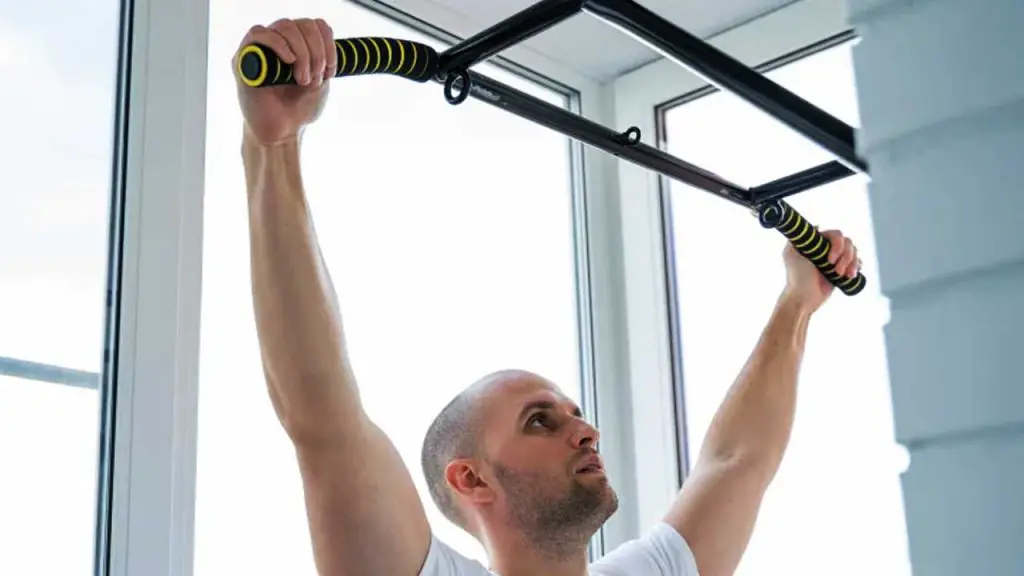
A doorway pull-up bar is a crucial piece of equipment for calisthenics training at home. It allows you to perform a variety of upper-body exercises, including pull-ups, chin-ups, and hanging leg raises.
To install one, you simply need a sturdy door frame and a few minutes to set it up. Make sure the pull-up bar is tightly secured before each use to avoid any accidents.
Parallettes
Parallettes are small, portable parallel bars that provide a solid platform for performing numerous calisthenic exercises. A good set of parallettes can be effective for working on your upper body strength, balance, and flexibility.
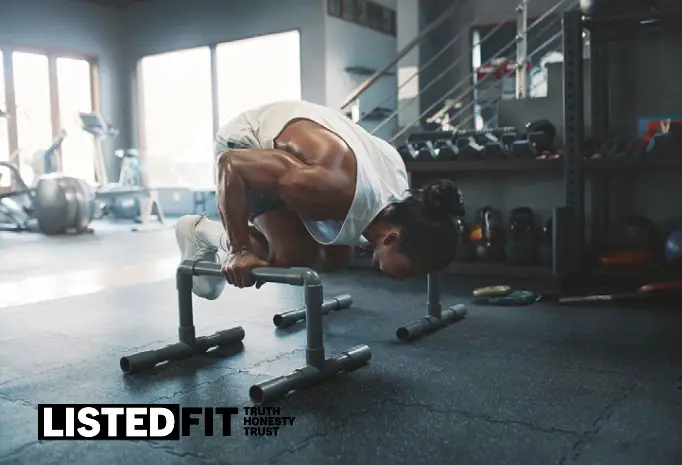
If you’re not used to using them, you will be very sore after your first workout!
With parallettes, you can perform exercises like dips, push-ups, L-sits, and handstands. They are a versatile and compact piece of equipment, making them a perfect addition to your home workout space.
Basic Weighted Vest
To enhance your calisthenics training and add resistance to your bodyweight exercises, consider a basic weighted vest. It increases the intensity of your workouts by adding an adjustable amount of extra weight to your upper body.
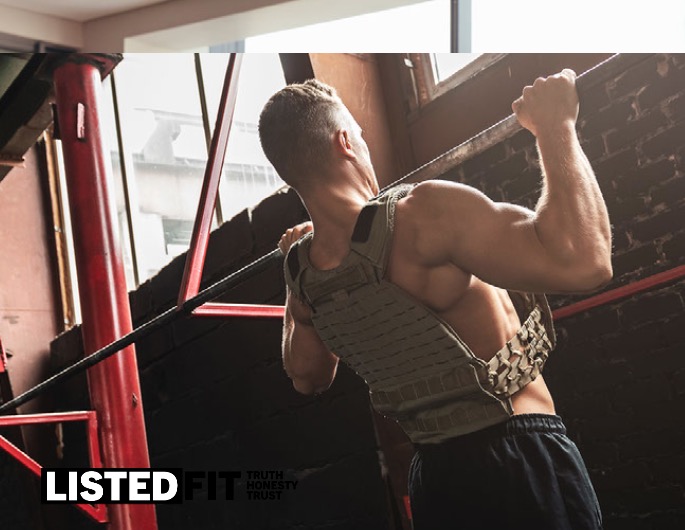
Some common exercises that can benefit from a weighted vest include push-ups, pull-ups, squats, and lunges. Ensure that the vest fits comfortably and securely to prevent any unnecessary strain or discomfort during your training sessions.
By incorporating these essential pieces of equipment into your home workout space, you’ll be well on your way to improving your calisthenic skills and overall fitness.
Pros of Calisthenics 👍
– Flexibility and Coordination
Calisthenics promotes flexibility, as bodyweight exercises often involve moving through a wide range of motion.
By practising these movements, you can improve your joint mobility and overall body coordination.
Moreover, calisthenics trains multiple muscle groups simultaneously, leading to a more functional and well-rounded fitness level. This can be beneficial in everyday activities and reduce the risk of injury.
– Balance and Core Strength
Through consistent calisthenics training, you will enhance your balance and core strength. Many of these exercises, such as handstands and L-sits, require a solid core to maintain proper form. By developing these essential muscles, you can improve your posture and stability in various physical tasks. Moreover, a strong core can help prevent lower back pain and other common ailments related to poor stability.
– Affordability and Convenience
One of the primary advantages of calisthenics is its affordability and convenience. You do not need a gym membership or expensive equipment to perform most bodyweight exercises.
Many basic movements can be done at home, in a park, or even during a break at the office. This makes calisthenics accessible to a wide range of individuals, regardless of their budget or location.
Cons of Calisthenics 👎
Limited Progression
While calisthenics can provide numerous benefits, there are certain drawbacks that you should be aware of.
One major disadvantage is the limited progression possibilities compared to weight training.
With calisthenics, your main resistance comes from your body weight, and it can be challenging to find ways to significantly increase the difficulty.
This limited progression might affect your long-term strength and muscle-building potential. In comparison, weight training allows you to add more weight to your exercises, providing a clear and structured way to progress.
This can lead to consistent and significant improvements in muscle mass and strength.
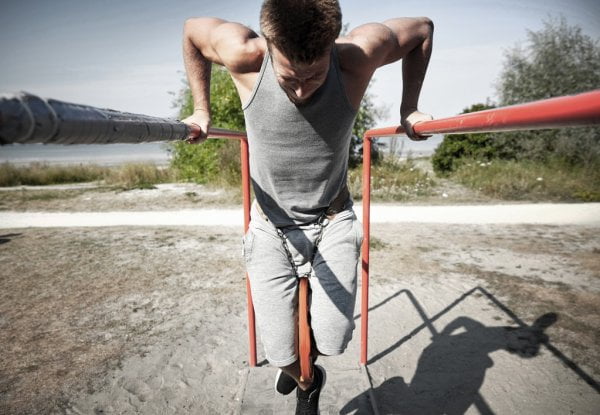
Of course, you can use things like a weighted vest or a dip belt to enable you to progress when doing moves like push-ups. But for argument’s sake, not having weights readily available as you would in a weight training scenario like a gym could be considered a drawback.
Learning Proper Form Can be a Little Trickier
Learning proper form is not as straightforward in calisthenics as in weight training. With weight training, you can often easily adjust the weight, allowing you to focus on form and gradually build up your ability to handle heavier loads.
Pros of Weight Training 👍
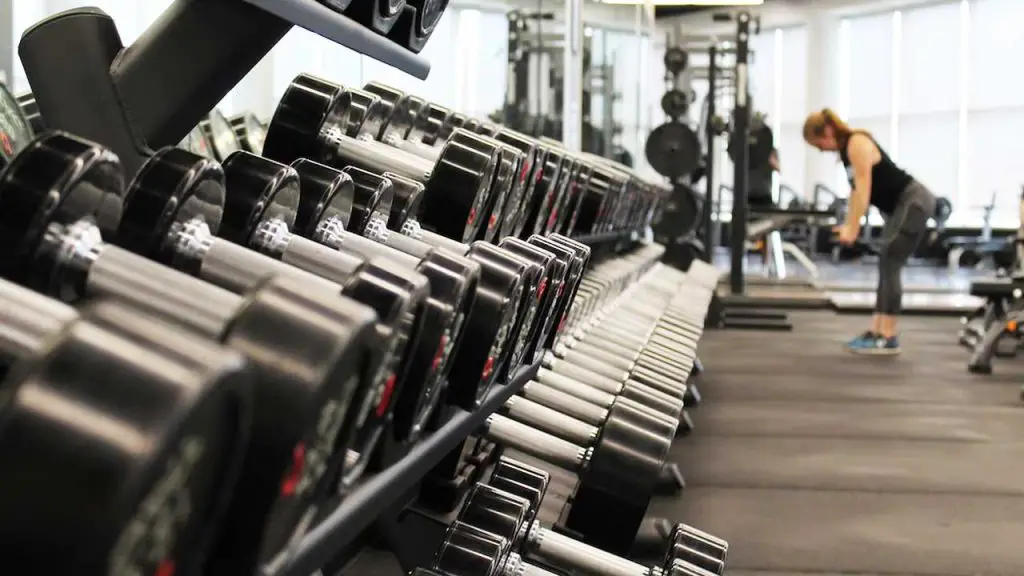
Greater Strength Gains
Weight training, which involves exercises using free weights like barbells and dumbbells, has been shown to result in significant strength gains over time.
By using these tools, you can target specific muscle groups and increase your ability to lift heavier loads. This type of training, which focuses on progressive overload, helps you build muscle mass and improve your overall strength.
Controlled Progression
One of the main benefits of weight training is the controlled progression that it offers. By adjusting the amount of weight used during exercises, you can manage your progression in a more systematic manner.
This makes it easier for you to increase the intensity of your workouts over time, ensuring that your muscles are constantly challenged and continue to develop.
Free weights, such as barbells and dumbbells, provide you with the flexibility to adjust the weight according to your current capabilities and personal goals.
Measurable Performance Improvements
Another advantage of weight training is that it allows for measurable performance improvements. By using specific equipment like free weights, you can track the weight used, the number of sets, and the repetitions performed during each exercise session.
This information can be used to monitor your progress, set new goals, and identify areas for improvement.
The ability to quantify your performance in this way is particularly valuable, as it enables you to better understand your own abilities and make informed decisions about your training programme.
Cons of Weight Training 👎
Expense and Accessibility
When it comes to weight training, one of the major drawbacks is the expense associated with it.
To work with weights, unless you are fortunate enough to have a good selection of equipment at home, you may need to invest in a gym membership, which can be costly.
On top of that, purchasing weights or machines for your home gym can also be expensive. This can be quite a barrier, especially when compared to calisthenics, which typically only require your body weight and minimal equipment.
Higher Risk of Injury
Another major concern with weight training is the higher risk of injury.
When lifting weights, it is more crucial to maintain proper form and posture to avoid causing strain or damage to your muscles and joints.
This can be particularly challenging for beginners who might not yet have a clear understanding of how to perform exercises with the correct technique.
If weights or machines are used incorrectly, or if you attempt to lift too much weight without proper preparation, you can easily injure yourself. This might lead to:
- Sprains
- Muscle tears
- Joint injuries
In comparison, calisthenics exercises tend to have a lower risk of injury, as they rely on your body weight and involve more natural movements.
But it is still essential to learn the correct form and technique for both calisthenics and weight training exercises to ensure a safe and effective workout.
Comparing Exercises and Techniques
In this section, we will explore the differences and similarities between calisthenics and weight training exercises. Understanding these exercises will help you decide which method is most suitable for your fitness goals.
Calisthenics Exercises
Calisthenics involves performing exercises using one’s bodyweight to develop muscular strength, endurance, and flexibility. These exercises often involve the entire body and help improve overall functional fitness. Some popular calisthenics exercises include:
- Squats: This bodyweight exercise targets the lower body muscles, such as the quadriceps, hamstrings, and glutes. To perform squats, stand with your feet shoulder-width apart and squat down as if sitting on a chair, maintaining a straight back and keeping your knees from extending beyond your toes. Return to standing position and repeat the exercise.
- Lunges: To perform lunges, take a step forward with one foot and bend both knees to lower your body. The front knee should be in line with the ankle and the back knee should almost touch the ground. Push back up to the starting position and repeat using the alternate leg.
- Push-ups: This upper body exercise targets the chest, shoulders, and triceps. Starting in a plank position, bend your elbows to lower your body towards the ground. Keep your body straight and aligned, then push yourself back to the starting position.
- Pull-ups: Pull-ups are an effective way to strengthen your back, shoulders, and arms. Find a pull-up bar at a suitable height, grasp the bar with an overhand grip and pull your body upwards until your chin is above the bar level. Lower yourself back down and repeat.
Weight Training Exercises
Weight training exercises involve using external weights, such as dumbells, barbells, or gym machines, to provide resistance. These exercises can be tailored to target specific muscle groups and are generally performed in sets and repetitions. Here are a few examples:
- Weighted squats: Similar to the bodyweight squat, weighted squats involve holding a barbell across your shoulders or using dumbbells in each hand to add extra resistance.
- Weighted lunges: Adding weights to lunges enhances the resistance and increases muscle development in the lower body. Hold a dumbbell in each hand or place a barbell on your shoulders while performing lunges.
- Bench press: The bench press is a fundamental upper body exercise that targets the chest, shoulders, and triceps. Lie on a bench holding a barbell or dumbbells and press the weight upwards, extending your arms fully before returning to the starting position.
- Deadlift: The deadlift is a compound movement that targets the lower back, hamstrings, and glutes. Stand in front of a loaded barbell, squat down and grasp the barbell with an overhand grip. Lift the barbell by extending your hips and knees, keeping your back straight, and return to the starting position.
But is Calisthenics Good for Building Muscle?
Calisthenics involves using your body weight to create resistance, such as push-ups, pull-ups, and squats.
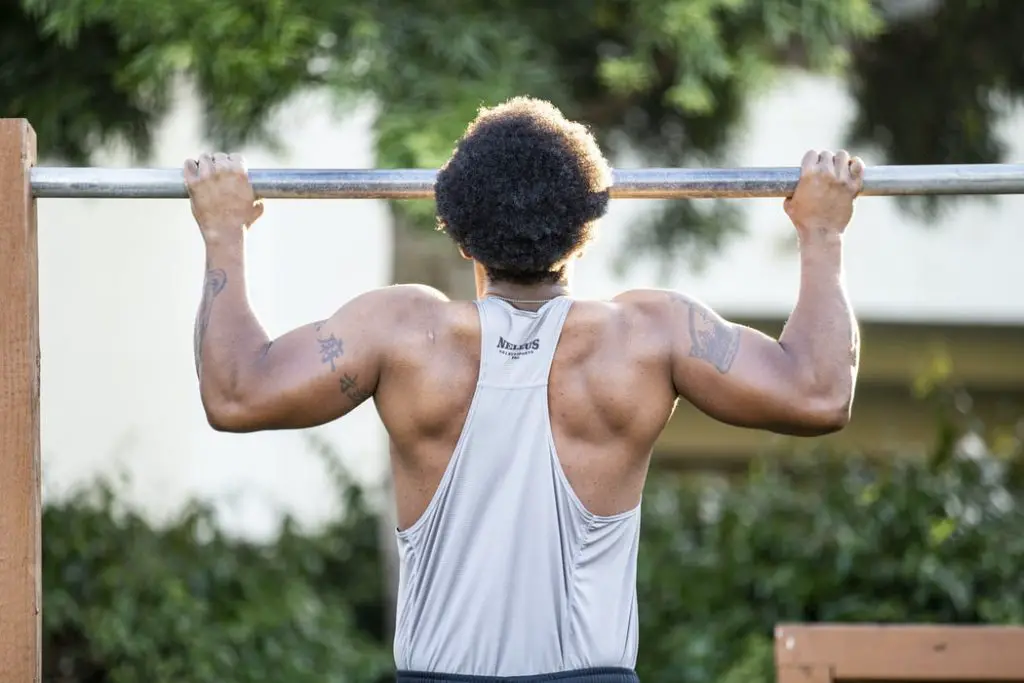
This type of training primarily targets compound muscle groups, engaging multiple muscles at once. While calisthenics can be an effective way to build muscle, it may not provide the same level of resistance as weight training, which can limit your potential for muscle hypertrophy.
Weight training, on the other hand, utilises external weights such as dumbbells, barbells, and machines to target muscle groups.
This method can isolate specific muscles and provide a variety of resistance levels, thereby enhancing hypertrophy.
Key advantages of weight training include:
- Greater control over resistance levels
- Easier progression and tracking
- Development of stabilising muscle groups
- Improved balance and coordination
If your goal is to maximise muscle growth, it’s key to have a combination of calisthenic and weight-training exercises in your routine.
Combining Calisthenics and Weight Training
By having both calisthenics and weight training in your routine, you can enjoy the benefits of each and ensure that you are challenging your body in different ways.
Here are a few tips on how to effectively combine calisthenics and weight training:
- Begin with compound exercises: Start your workouts with compound exercises from both calisthenics and weight training, like pull-ups, squats, or bench presses.
These exercises target multiple muscle groups and improve overall strength, but more importantly, in order to get the most out of them you need to have more energy so aim to do these at the beginning of your workout. - Incorporate isolation exercises: After compound exercises, focus on isolation movements such as bicep curls or tricep extensions with weight training, or leg raises and calf raises for calisthenics. These exercises target specific muscle groups for hypertrophy.
- Integrate progressive overload: You have to make sure that you incorporate progressive overload by increasing the intensity of your workouts over time.
The most common form of this is increasing the weight, sets, or reps for weight training exercises and making calisthenic movements more challenging, e.g., by elevating your feet during push-ups. - Consider periodisation: Structure your workout routine to alternate between periods of focus on calisthenics and weight training.
This will help prevent plateaus and moments of boredom and help you to maintain consistent progress in your muscle growth and performance.
Maintaining Safety and Injury Prevention
Proper Form and Technique
When engaging in both calisthenics and weight training, a crucial aspect to consider is proper form and technique.
This ensures that you are performing the exercises correctly and minimising the risk of injury. For calisthenics, focus on body alignment and smooth, controlled movements to activate the right muscle groups.
For weight training, selecting an appropriate weight and maintaining proper posture during each lift is vital. Additionally, avoid locking your joints or using momentum to complete a repetition. Always seek guidance from a fitness professional if you’re unsure about your form or are new to these exercises.
Rest and Recovery
Ensuring adequate rest and recovery is essential for the prevention of injuries and promoting overall well-being. Both calisthenics and weight training place stress on your muscles, which need time to repair and recover. Aim to get sufficient sleep and incorporate rest days into your exercise routine.
Listen to your body and recognise the signs of overtraining, such as fatigue, reduced performance, and persistent soreness. Schedule your workouts to avoid excessive strain on any muscle group and remember to include different forms of exercises, such as cardio and flexibility training, to maintain a balanced fitness regime.
Incorporating Cardio and Metabolic Training
What Is HIIT High-Intensity Interval Training
High-Intensity Interval Training (HIIT) can be an effective addition to your calisthenics or weight training routine, as it can increase your metabolic rate and help you achieve your weight loss goals.
HIIT involves alternating between intense bursts of activity and periods of lighter activity or rest. This approach can help you burn more calories during your workout and improve your cardiovascular fitness.
By incorporating HIIT into your calisthenics or weight training programme, you can achieve a more balanced and efficient workout. For example, you could alternate between pull-ups, push-ups, squats, and jumping jacks, performing each exercise for 30 seconds, followed by a 30-second rest period. This approach allows your muscles to recover while still engaging in a challenging and diverse workout.
Functional Fitness
Functional fitness aims to enhance your ability to perform everyday tasks with greater ease through exercises that mimic common movements.
Calisthenics and weight training can both be effective forms of functional fitness training. However, calisthenics has a slight edge over weights in terms of functional strength since it primarily uses bodyweight exercises that challenge multiple muscle groups simultaneously.
By incorporating functional exercises into your training plan, you can improve your overall stability, flexibility, and mobility. Utilise a variety of exercises, such as planks, lunges, and squats, to target different muscle groups and activities. It’s essential to focus on proper form and steady progression in both calisthenics and weight training to avoid injury and ensure optimal results.
Frequently Asked Questions
Are calisthenics stronger than bodybuilders?
Calisthenics and bodybuilding are two different forms of exercise, each with its own strengths and goals. Calisthenics focuses on using your bodyweight as resistance, aiming to improve functional strength, flexibility, and mobility.
Bodybuilding, on the other hand, involves lifting weights to increase muscle size and strength. While calisthenic athletes may excel in bodyweight exercises, bodybuilders typically have greater overall muscle mass and strength.
It’s not about one being stronger than the other, but rather which approach aligns with your fitness goals.
Bodyweight vs weight training for fat loss
Both bodyweight training and weight training can be effective for burning calories and promoting fat loss.
The key for both approaches is intensity, frequency, and consistency in your workouts.
Combining cardio with either calisthenics or weight training will help to further increase your caloric burn and support fat loss.
Ultimately, the best choice for fat loss is the one that you enjoy and can maintain over time.
Calisthenics vs weights results
The results you can expect from calisthenics or weight training will depend on the individual, their goals, and their programme.
Calisthenics can lead to improvements in functional strength, flexibility, and body control. Weight training focuses on building muscle mass and strength.
Both forms of training can provide you with overall physical fitness improvements, but the specific results will vary based on your commitment and training regimen.
Is calisthenics good for skinny guys?
Calisthenics can be beneficial for individuals of all body types, including “skinny guys”. Bodyweight exercises can help build strength, endurance, and muscle definition without the need for additional equipment.
For those looking to add muscle mass, incorporating progressive overload techniques – such as increasing the number of repetitions, sets, or modifying the movement – can help promote muscle growth.
Bodyweight vs weights for muscle gain
Both bodyweight training and weight training can lead to muscle gain.
But weight training may provide faster and more significant muscle growth, primarily due to the ability to easily apply progressive overload.
By consistently increasing the weight lifted, muscle fibres experience greater stress, promoting growth.
Calisthenics can also lead to muscle gains, but progressive overload may be more challenging to achieve compared to weight training.
Can you build muscle with only calisthenics?
Yes, you can build muscle with only calisthenics. By consistently performing challenging bodyweight exercises and incorporating progressive overload techniques, you can promote muscle growth.
Ensure you maintain proper nutrition, including adequate protein intake, to support muscle recovery and growth.
While it might take longer to build muscle with calisthenics compared to weight training, it is still possible to achieve significant growth and strength gains.
Author
- Danny Loeb is a qualified Personal Trainer, Fitness Model and Writer. He enjoys blogging about health and fitness, messing around with Photoshop, and sharing his experiences with everyone.
Latest entries
 NutritionFebruary 6, 2024What Are Fillers in Supplements? – Unveiling Inactive Ingredients
NutritionFebruary 6, 2024What Are Fillers in Supplements? – Unveiling Inactive Ingredients FitnessAugust 23, 2023Best Post-Workout Foods: Great Ideas for Recovery and Results
FitnessAugust 23, 2023Best Post-Workout Foods: Great Ideas for Recovery and Results BulkingJuly 26, 2023Is Rice Good for Bulking? Unveiling the Truth
BulkingJuly 26, 2023Is Rice Good for Bulking? Unveiling the Truth CultureJuly 15, 2023Why Do People Hate Planet Fitness? Read This Before You Join!
CultureJuly 15, 2023Why Do People Hate Planet Fitness? Read This Before You Join!
Affiliates:
This post may contain affiliate links that at no additional cost to you, the site may earn a small commission. We only recommend products we would use ourselves and all opinions expressed on this site are our own.
General Advice:
The information provided in this article is for general informational purposes only. It is not intended as a substitute for professional advice. Always consult with a qualified healthcare professional before starting any new diet, exercise program, or making changes to your health routine.
Accuracy Advice:
While we strive to provide up-to-date and accurate information, the content in this article may not reflect the most current research or medical guidelines. We encourage readers to do further research and consult with professionals for more personalized advice.
Our Recommendations:
The products and services mentioned in any of our articles are recommended based on our independent research and personal experience. We are not sponsored by any company. We aim to suggest products and services we believe are of high quality and could be beneficial to our readers.




